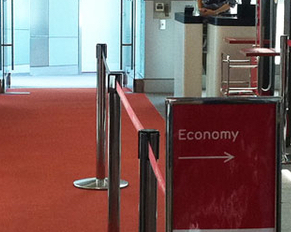One of the most powerful motivators of a tiered loyalty program is what happens “on the other side of the rope”.
Being rewarded with the benefits earned in a higher tier of a loyalty or rewards program creates a sense of:
“I feel special” (exclusivity);
“Look at me” (status) and
“I’ve earned this” (achievement).
The impact of these feelings for the member is heightened when it’s in a public setting, increased by a mix of:
- Sight (visible signage, banners, carpets, roped off areas, club lounges, VIP parking)
- Sound (a public announcement calls out first for the higher tiered members) and
- Saying hello (greeting a higher tiered member has some extra nuances of recognition)
There are also other benefits that are less public which are crafted for higher tiered members.
Airline and hotel loyalty programs most commonly have tiered programs that use a mix of sight, sound and ‘saying hello’ to recognise higher tiered members.
However, there is also an impact on those not receiving the benefits of the higher tiers, especially in a public setting.
It’s called The Bystander Effect
According to the Journal of the Academy of Marketing Science, the research study - “Understanding loyalty program effectiveness: managing target and bystander effects”, highlights that loyalty programs with tiered benefits (“prestigious club benefits”) should also focus on the members who are NOT receiving the higher tiered benefits.
What’s the impact on these “bystanders” or lower tiered members and also non-members when they can see and hear how higher tiered members are being treated?
Thoughts and feelings include - “I’m not special”; “I want what they have - how do I achieve that status to earn those benefits”; “there’s no point in joining as I’ll never get there”.
A program’s blend of benefits needs to consider BOTH sides of the rope
Understanding this mix of negative emotions and acceptance of their earning reality for these “bystanders” when building a program’s blend of benefits, ensures a focus on clearly defining and explaining the rules of reward achievability and program engagement.
While the focus of tiered programs is to influence and reward specific member behaviours (spend more, fly more, stay more), taking a step back to consider the “bystanders”, will give you a greater opportunity to craft your program proposition and communications to alleviate or accentuate their feelings.
On the “side of the rope” where members are enjoying the benefits of the higher status earned, it’s important that program managers also deliver to their expectations.
What “bystander effect” have you experienced – on either side of the rope?
Have a happy loyalty day!


